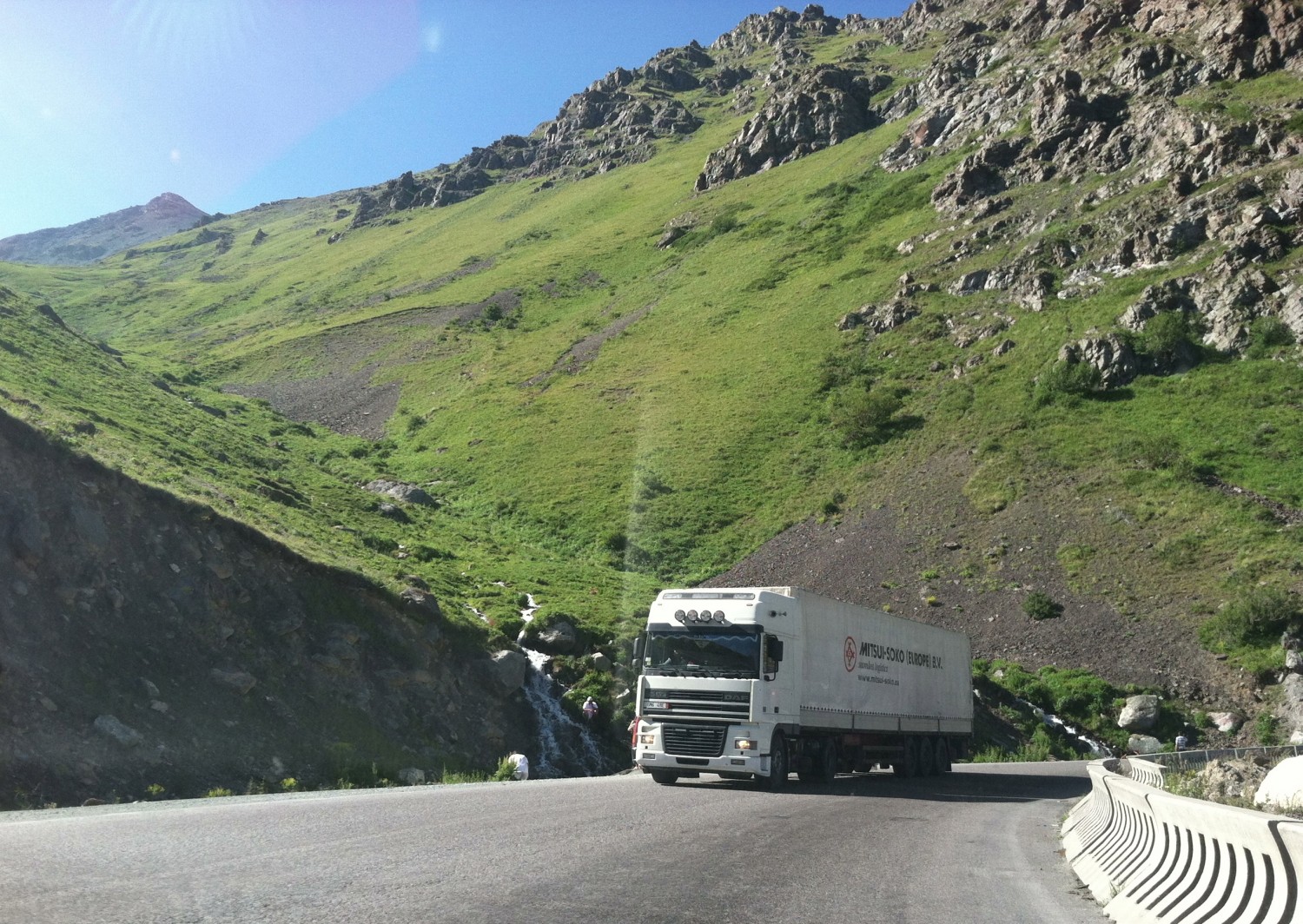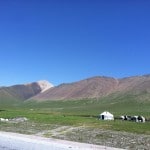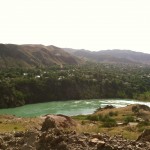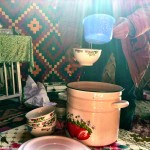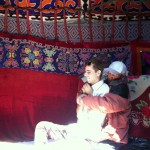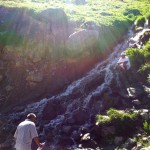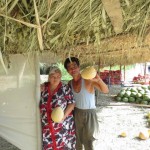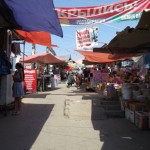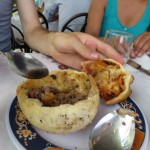This past weekend, I visited Osh, the “southern capital” of Kyrgyzstan. I’ve always wanted to go because I heard the 620-kilometer Bishkek-Osh Highway, the only main road connecting Russia with the south of Central Asia, was gorgeous. I also wanted to see “the south.” People always talk about Kyrgyzstan’s cultural, linguistic, and political “north-south divide,” and I wanted to see firsthand the city that represents the “other Kyrgyzstan,” which has a large Uzbek population. (I have heard estimates ranging from 40-60 percent.) Thirdly, I wanted to be in the heart of Kyrgyzstan’s “conflict zone,” the site of the terrible ethnic riots between the Uzbeks and Kyrgyz in 2010 that left hundreds dead, thousands injured, and many families split apart when many escaped to Uzbekistan and Russia. Today, those events remain an open wound. There is no consensus on what caused the violence. And the pain and hurt caused by the killings between the Kyrgyz and Uzbeks are still raw and real. Osh may be a peaceful city today, but three years ago it was Kyrgyzstan’s city of blood. As a student of Central Asian history and security issues, I wanted to see the infamous city myself.
One very early Saturday morning, two of my friends and I went to one of Bishkek’s main bazaars, the aptly named Osh Bazaar, to find a taxi that would take us to this southern city. We were prepared to pay 5,000 som for three people for a private taxi, a figure given to us by a local. Locals recommend taking taxis for small groups like ours. However, we were not prepared for the cluster “fun” that awaited us. We were passed from driver to driver, as if in a game of hot potato, and each driver presented us with his vehicle, his price, his deal, while the rest of his comrades looked amusingly on as spectators. It was all a game — it’s always a game — and we didn’t know the rules. It was like the drivers wanted us, but didn’t want us at the same time.
What I learned from the experience is that haggling with taxi drivers at Osh Bazaar in Bishkek — or anywhere in Kyrgyzstan for that matter — is not for the faint-hearted. Russian helps, of course. So does a little meanness. At least one should have a passable game face (ie. steely eyes, rough voice, and a no-nonsense attitude) for the hoards of taxi drivers who will surround you and tell you almost anything to get you into their taxis. Especially taxi drivers from Osh Bazaar, which is infamous for pick-pockets and other hooligans. I know many locals who avoid Osh Bazaar. Of course, when you’re obviously foreign it almost doesn’t matter what you say, as you will be treated as walking gold mines. But attitude, and a number for the police (threatening to call the militsia almost always works), will help. But of course, I say this now in hindsight.
We ended coming to an agreement with a taxi driver for our price. And when one of the comrades asked for 2,000 som (~$40) upfront (and supposedly 3,000 som later), we gave it.
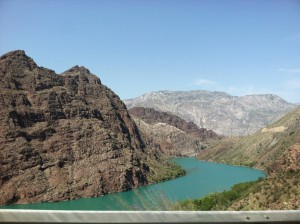
The next 14 hours on the Bishkek-Osh Highway were spectacular. The landscapes really are as beautiful and as stunning as everyone says they are. It is true that you can see all four seasons during the drive. We snaked along green mountains, sparkling reservoirs, red canyons, corn fields, wheat fields, cotton fields, green pasture land, high steppe plateau. We shared the road with roaming goats, wild horses, flocks of sheep. We passed by yurts, one of which we stopped at for kumis (fermented mare’s milk). We held our breath as our driver tempted fate as he overtook truck after truck on the narrow winding roads. We also watched our driver almost drive off the cliff because he was dozing (but our good friend in the passenger seat swerved him back to safety just in the nick of time.) We waded in one of the most beautiful reservoirs in Central Asia, the Toktogul Reservoir, alongside sunburned Kyrgyz families and splashing naked babies. We ate sweet watermelons and cantaloupes at a roadside fruit stand. We had lunch at a chaikhana (teahouse) where we sprawled out on a topchan (bed table) and cooled ourselves Central Asian-style with a pot of hot green tea. We ducked behind bushes for bathroom breaks. We smiled embarrassedly as our driver took pictures of us with our cameras, while pushing locals into the shot, saying, “Take a picture with Americans!” And we drank bottles and bottles of water and Coca-Cola. It was hot, and the taxi was not air-conditioned.
The ride down was exactly what I had hoped for: a gorgeous ride with good company and with the comforts of a private car that could stop whenever and wherever we pleased.
If only the ride ended as peacefully. When we got into Osh late that evening, our driver completely claimed ignorance about the 2,000 som that we had already dished out, and demanded the full amount. We looked at our wallets in disbelief. The evening quickly dissolved into an uncomfortable, awkward, and angry situation. Now, I hear of taxi drivers pulling this stunt all the time in Bishkek, and how people deal with it by simply paying the originally-agreed-upon price and literally running away, because taxi drivers will rarely run after you. But we were stuck in front of our hotel in an unfamiliar city. Where were we going to run, into the hotel with our flapping backpacks? In the end, we renegotiated, and managed to pay just 800 som ($16.00) more than the original agreement. But what an unfortunate turning of events. We went to a local café off Lenin Street to end the evening with beer and shashlik.
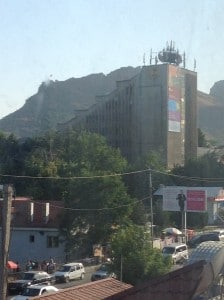
That next day, Sunday, we explored the city. It started with a hike up the famous 1,000-meter-high “Suleiman Too,” or Solomon’s Mountain, which dominates the city center’s landscape and is where the Prophet Muhammed once prayed. The Solomon Mountain was the first site in Kyrgyzstan to be included in the UNESCO World Heritage Site because the site “is believed to represent the most complete example of a sacred mountain anywhere in Central Asia, worshipped over several millennia.” On top is a mosque built in 1497 by 14-year-old Babur, the crowned King of the Ferghana Valley, before he became the founder of the Mogul dynasty in India. It is also believed that climbing up the mountain will make a woman pregant. But my local Kyrgyz friend doesn’t believe it; she’s climbed it three times already and is still not pregnant.
We lunched at a chaikhana with the traditional Uzbek dishes of tandirnaya samsa and plov. They were sufficiently greasy and delicious, perfect with hot green tea. You can certainly find these items in Bishkek, but you’ll have to look hard to find them prepared authentic Uzbek-style. In Osh, samsa is bigger and crunchier, and plov has red rice (grown on red clay soil) and yellow carrots.
Then we walked around the Jayma Bazaar, considered one of Central Asia’s best markets because of its vast selection of Uzbek, Kyrgyz, Tajik, and Chinese items along the Ak-Buura River. There, we bought insanely cheap kalpaks (the Kyrgyz national felt hat) that ranged from 50 to 200 som. Kalpaks of that size and quality would have been three times more expensive at Osh Bazaar in Bishkek. Jayma Bazaar is a refreshing change from the teeming claustrophia of Osh Bazaar. We wandered around without clutching our bags to our chests.
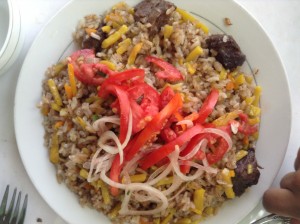
In the afternoon, we walked around the park in front of the Historical Museum, where we sat on a bench in front of the fountains and people-watched. The park was mostly filled with young families. Young kids drove around in toy cars, as their parents followed them with the remote control. Kids posed Soviet-style (no smile, standing at attention) for their mother’s clicking cameras. Gypsies walked around and tugged at our clothes for money. As we sat in silence, trying not to think about the heat, our Uzbek acquaintance finally said, “Well, guys, I think you’ve pretty much seen Osh. This was everything interesting.” I looked at my watch. It was about 7:30pm.
We ended the evening with a pleasant dinner at another shashlik joint, serenaded by Ramadan carolers (an Uzbek tradition where children sing for candy or money during the month of Ramadan). The following morning, two of us took the comfortable 40-minute flight back to Bishkek, while our third friend continued on to the Pamirs.
So there you have it, Osh in 36 hours. Was it crazy to drive 14 hours for a 36-hour trip to Osh? Maybe. But I’m glad I did it, possible death and robbery aside. It was one of the most beautiful road trips I have ever taken. It really was a “it’s the journey, not the destination” situation. Osh itself is not bad. It’s a quiet and calm city, and there are important historical sites worth visiting, if you’re in Kyrgyzstan anyways. And it’s probably the closest thing you’ll come to being in Uzbekistan, without having to cross the border. But if I had to do it all over again, I would probably break up the drive on the Bishkek-Osh Highway and stop overnight in Arslanbob, the famous walnut grove. And then I would spend a day in Osh, then fly back to Bishkek.
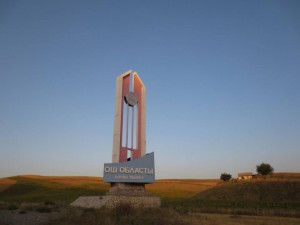
That being said, I would be very interested in returning to Osh one day to do research on the ethnic conflict in 2010, to peel away the layers of dried blood to learn more about what happened, and more importantly, why it happened, so that we could prevent it from happening again. It’s amazing how tight-lipped people are about the tragedy that occurred only three years ago. Mistrust, suspicion, and fear live on, even if the blood has subsided. Today there are still many Uzbeks and Kyrgyz people in Russia who are afraid to return back to Osh for fear of being accused by the police of participating in the three-day violence, even though most of them fled the country to save their lives. As one of my Uzbek colleagues in Bishkek said: “Chas spokoino, no liudi ne liubyat drug druga.” (“Now it’s peaceful, but people do not love each other.”)
So, drive to Osh for the mountain and plov and samsa and cheap kalpaks. It’s a pleasant southern city. Breathe in this side of Kyrgyzstan. Just be prepared to catch more than a whiff of Uzbek spices. Every now then a flurry of the past will catch you offguard. When I think of Osh, I will always remember both the delicious Uzbek food and the charred restaurants of Lenin Street which were burnt down three years ago when all hell let loose.

